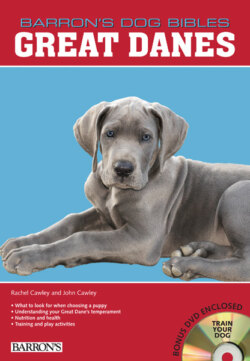Читать книгу Great Danes - Rachel Cawley - Страница 14
На сайте Литреса книга снята с продажи.
The Name Game
ОглавлениеMore than the average breed, the Great Dane has gone through a variety of names. In the 1800s, the dog’s name became a point of contention between England and Germany. The first German dog show (1863) featured two similar breeds: the Dannish Doggen and the Ulmer Doggen. By 1876 the judges began to refuse to allow both names, saying that the dogs were the same breed and only the Deutsche Dogge name was to be used. At the 1879 Hanover show it was decided that the lighter-weight dogs would be Ulmer Doggen and the heavier-weight dogs would be Danish Dogs. More confusing was that Brindle Great Danes were called Hatzruden (Wolf Dogs)!
The 1880 publication of Sydenham Edward’s encyclopedia Cynographia Britannica (an encyclopedia of British dog breeds) lists the “Great Danish Dog” with an illustration. It describes the dog as being a cross between Greyhounds and Mastiffs with usually cropped ears. The text even mentions “a beautiful variety called the Harlequin Dane.”
That same year, a meeting of German breeders and judges agreed that the breed developed in Germany was substantially different from the English Mastiffs. The group insisted the name be changed to Deutsch Dogge (German Dog), forbade all other names, and founded the Deutshe Doggen Club of Germany.
FYI: A Great Dane by Any Other Name …
Here are the names for Great Danes in a few international tongues.
• Great Dane (English-speaking world and Denmark)
• Gran Danés (Spanish- and Portuguese-speaking world, including South America)
• Grand Danois (French-speaking world, Scandinavia in the twentieth century)
• Tanskandoggi (Finland)
• Danubius Dog (Hungary)
• Danua cinsi kopek or Grand Danua (Turkey)
• Danische Dogge or Grosse Danische Yagd Hund (German-speaking world until 1888–1889)
A British club for the breed was formed in 1883. The breed was previously shown as German Boarhounds, but it was decided to name the club the Great Dane Club and include all the name variations, including Boarhounds, Tiger Mastiffs, and German Mastiffs. The name change prompted Prince Solins of Prussia to demand that the British club retain the dog’s national origin and call it the Great German Dogge Club. The British ignored the request and kept the Great Dane name.
In 1884, English shows began listing the dog as the Great Dane. The club broke with the rest of the world when it ceased cropping the ears in 1894. King Edward VII, then the Prince of Wales, requested that all cropping be stopped. (Since then, many other countries have outlawed the practice of cropping, calling it everything from barbaric to unnecessary surgery.)
The year 1887 found the breed being recognized by the American Kennel Club. In 1889, the Great Dane Club of America (until then the breed was called the German Mastiff) was founded in Chicago. In 1891, the Great Dane Club of Germany accepted an official description or standard for the breed.
